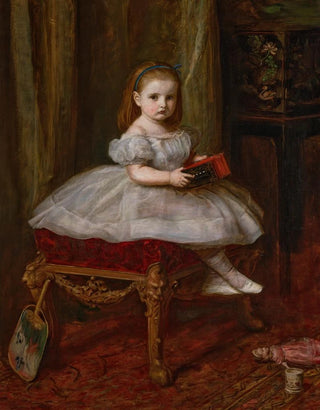Art print | Portrait of Miss Davison - Sir John Everett Millais


View from behind

Frame (optional)
Sir John Everett Millais's "Portrait of Miss Davison" is an iconic artwork that embodies the refinement and sensitivity of Victorian painting. This painting, created in the heart of the 19th century, does more than capture the appearance of a young woman; it also reveals the nuances of her character and spirit. Through Miss Davison's penetrating gaze and delicate posture, Millais invites us to explore an emotional intimacy that transcends a simple portrait. The soft light and rich colors of the canvas create an almost ethereal atmosphere, captivating the viewer and drawing them into a universe where time seems suspended.
Style and uniqueness of the work
What sets the "Portrait of Miss Davison" apart is its innovative approach to portraiture. Millais, a founding member of the Pre-Raphaelites, moves away from the academic conventions of his time to embrace a more direct and expressive style. The oil painting technique, used with remarkable mastery, allows for the creation of detailed nuances, rich textures, and fascinating plays of light. The background, subtly blurred, highlights the central figure, thus emphasizing the importance of Miss Davison in the composition. The artist succeeds in blending realism and poetry, making each element of the painting meaningful. This portrait is not limited to a simple representation; it becomes a window into the soul of its subject, an exploration of human emotions that still resonates today.
The artist and his influence
Sir John Everett Millais is a key figure in the history of British art. As a co-founder of the Pre-Raphaelites, he played a vital role in redefining the artistic standards of his era. His commitment to nature, truth, and beauty has inspired many artists and continues to influence subsequent generations. Millais, through his meticulous technique and keen sense of color, was able to capture moments of rare emotional intensity. The impact of his work extends beyond the borders of England, touching artists around the world. His unique approach to portraiture, emphasizing psychology and characterization, opened

Matte finish

View from behind

Frame (optional)
Sir John Everett Millais's "Portrait of Miss Davison" is an iconic artwork that embodies the refinement and sensitivity of Victorian painting. This painting, created in the heart of the 19th century, does more than capture the appearance of a young woman; it also reveals the nuances of her character and spirit. Through Miss Davison's penetrating gaze and delicate posture, Millais invites us to explore an emotional intimacy that transcends a simple portrait. The soft light and rich colors of the canvas create an almost ethereal atmosphere, captivating the viewer and drawing them into a universe where time seems suspended.
Style and uniqueness of the work
What sets the "Portrait of Miss Davison" apart is its innovative approach to portraiture. Millais, a founding member of the Pre-Raphaelites, moves away from the academic conventions of his time to embrace a more direct and expressive style. The oil painting technique, used with remarkable mastery, allows for the creation of detailed nuances, rich textures, and fascinating plays of light. The background, subtly blurred, highlights the central figure, thus emphasizing the importance of Miss Davison in the composition. The artist succeeds in blending realism and poetry, making each element of the painting meaningful. This portrait is not limited to a simple representation; it becomes a window into the soul of its subject, an exploration of human emotions that still resonates today.
The artist and his influence
Sir John Everett Millais is a key figure in the history of British art. As a co-founder of the Pre-Raphaelites, he played a vital role in redefining the artistic standards of his era. His commitment to nature, truth, and beauty has inspired many artists and continues to influence subsequent generations. Millais, through his meticulous technique and keen sense of color, was able to capture moments of rare emotional intensity. The impact of his work extends beyond the borders of England, touching artists around the world. His unique approach to portraiture, emphasizing psychology and characterization, opened






